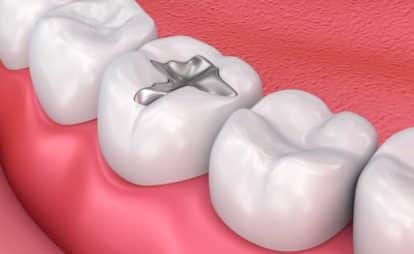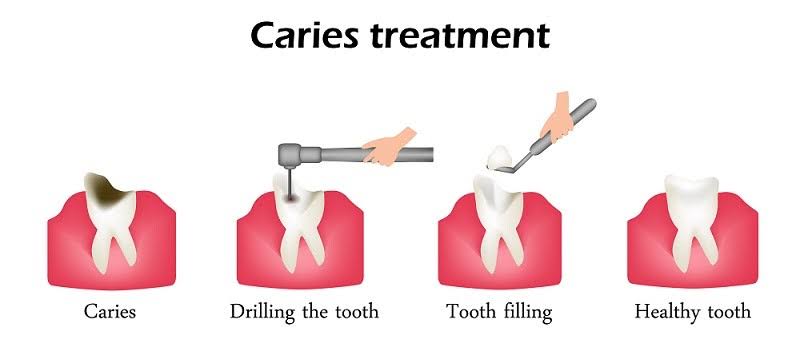Dental Filling Types and Procedure in Ahmedabad
A dental filling helps to save the damaged tooth which was caused as a result of tooth decay. It is a cost-effective treatment that cleans the teeth and replaces them with proper dental fillings. This filling helps to prevent it from further getting damaged and bacteria development. If you reside in Ahmedabad and need a better dental filling treatment then visit the nearest branch of Sabka dentist to get quality treatment.

Talk to a Dentist Now!
What is a Dental Filling?
A filling is a way to restore a tooth damaged by decay back to its normal function and shape. When a dentist gives you a filling, he or she first removes the decayed tooth material, cleans the affected area, and then fills the cleaned out cavity with a filling material.

By closing off spaces where bacteria can enter, a filling also helps prevent further decay. Materials used for fillings include gold, porcelain, a composite resin (tooth-colored fillings), and an amalgam (an alloy of mercury, silver, copper, tin and sometimes zinc).
When do you need a Dental Filling?
Dental Filling in Ahmedabad, Sabka Dentist use several methods to determine if you have tooth decay and need a dental filling, including:
- Observation — Some discolored spots on your teeth may indicate decay, but not all of them. Your dentist may use an explorer, a metal instrument with a sharp tip, to probe for possible decay. Healthy tooth enamel is hard and will resist pressure by the explorer. Decayed enamel is softer. The instrument will stick in it slightly.
- Cavity-detecting dye — This can be rinsed over your tooth. It will color the decayed areas and rinse away from healthy ones.
- X-rays — X-rays can help your dentist see decay that doesn’t show on the surface. However, X-rays are often not accurate in detecting smaller cavities on occlusal (top) surfaces. Current fillings or other restorations also may block the view of decay. They also help in detecting caries that are present below fillings.
- Laser fluorescence cavity detection aids — This measures changes caused by caries (tooth decay). They are especially useful for pit and fissure areas.
Decay is not the only reason you may need a filling. Other reasons include:
- Cracked or broken teeth
- Teeth that are worn from unusual use, such as:
- Nail-biting
- Tooth grinding (bruxism)
- Using your teeth to open things

What are the steps to a filling?
When you visit your dentist to get a filling, you may be given local anesthesia to numb the area if necessary after which your dentist will remove decay from the tooth, using hand instruments or a drill. Air abrasion and lasers also can be used to remove decay.
At first, your dentist will use a high-speed drill (the one with the familiar whining sound) to remove the decay and unsupported enamel of the tooth. Once the drill reaches the dentin or second layer of the tooth, the dentist may use a lower speed drill. That’s because dentin is softer than enamel.
Once all the decay is removed, your dentist will shape the space to prepare it for the filling. Different types of fillings require different shaping procedures to make sure they will stay in place. Your dentist may put in a base or a liner to protect the tooth’s pulp (where the nerves are).
The base or liner can be made of composite resin, glass ionomer, zinc oxide, and eugenol, or another material.
Some of these materials release fluoride to protect the tooth from further decay.
If your dentist is placing a bonded filling, he or she will etch (prepare) the tooth with an acid gel before placing the filling.
Etching makes tiny holes in the tooth’s enamel surface. This allows the filling to bond tightly to the tooth. Bonded fillings can reduce the risk of leakage or decay under the filling. That’s because the etched surface of the tooth and the filling material form a mechanical bond. Bonding is generally done with composite fillings.
Certain types of fillings get hardened by a special light. With these fillings, your dentist will stop several times to shine a bright light on the resin. This cures (hardens) the material and makes it strong.
Finally, after the filling is placed, your dentist will use burs to finish and polish the tooth.
What care should be taken after filling?
Some people feel sensitivity after they receive a filling due to pressure, air, sweet foods or cold. Composite fillings often cause sensitivity.
In most cases, the sensitivity will subside over one to two weeks. Until then, try to avoid anything that causes it. If your tooth is extremely sensitive or your sensitivity does not decrease after two weeks, contact your dentist’s office.
It’s important to let your dentist know about any sensitivity you are feeling. The next time you need a filling, he or she may be able to use a different material and make changes to reduce sensitivity. People vary in their response to different materials. Your dentist has no way of predicting if your tooth will react to a particular material.
When you talk to your dentist about the sensitivity, try to describe it as precisely as possible. This information will help decide what should be done next. Your dentist may take out the filling and put in a new one. He or she may add a base, liner or desensitizing agent on the tooth as well.
If the filling was very deep, you could need a root canal treatmentto solve the problem.
Besides sensitivity, some people feel discomfort when they bite down. There are two types of pain, each with a different cause.
The first type occurs when you bite, and worsens over time.
This is caused by a filling that is too high and interferes with your bite. Once your anesthetic wears off, you would notice this right away. Contact your dentist. You will need to return to the office to have the filling reshaped.
The second type of discomfort is a very sharp shock that appears only when your teeth touch.
This is called galvanic shock. It is caused by two metals (one in the newly filled tooth and one in the tooth it’s touching) producing an electric current in your mouth. This would happen, for example, if you had a new amalgam filling in a bottom tooth and had a gold crown in the tooth above it.
Your dentist polishes the filling after it is placed, but occasionally sharp edges may remain. You can’t detect this at first because of the anesthesia. If you find one, contact your dentist and arrange to have it smoothed as soon as possible to avoid injury to your tongue or mouth.
Temporary Fillings
You may receive a temporary filling (usually white, off-white or gray) if:
- Your treatment requires more than one appointment.
- Your dentist wants to wait a short period of time for the tooth to heal.
- You have a deep cavity and the pulp (containing the nerve and blood vessels) becomes exposed during treatment.
- You need emergency dental treatment.
A temporary filling may make your tooth feel better. This is because the filling seals the tooth, protecting the pulp from bacteria and reducing sensitivity.
Temporary fillings often contain eugenol, an ingredient in over-the-counter toothache remedies. Eugenol is also a component of oil of cloves, which people use for toothache pain.
Temporary fillings are not meant to last. Usually, they fall out, fracture or wear out within a month or two. If you get a temporary filling, make sure you visit your dentist to get a permanent one. If you don’t, your tooth could become infected or you could have other problems.
Why Replace a Filling?
Fillings don’t last forever. They can become discolored. Composite, tooth-colored fillings pick up stains, and yellow or darken over time. When you chew, your teeth and any fillings in them are subjected to tremendous pressures. Even if no other problems develop, some fillings will wear out over time and will need to be replaced.
A filling will need to be replaced earlier if it falls out, leaks or cracks.
Food debris and bacteria can seep down under a filling that is cracked or leaking. Since you can’t clean there, the bacteria feed on the food debris and form the acid that causes tooth decay.
Decay under a filling can become extensive before you notice it or it causes you pain. This is why you should have your fillings checked regularly and get them replaced when problems are found.
Why do fillings fall out?
Fillings can fall out for several reasons:
- You bite down too hard on a tooth that has a large filling and break the filling or the tooth.
- The filling material that was used cannot withstand the forces placed upon it. For example, if you have broken a large piece of your front tooth, a porcelain (tooth-colored) crown is probably a good treatment choice. In some cases, a dentist may place a composite filling instead. This may look good or acceptable. However, if the composite is too large, a strong biting motion may break the plastic material.
- The cavity is contaminated with saliva when the filling is placed. For composite resins, this will disrupt the bonding of the material. As a result, the bond will not stick well to the tooth and it may fall out.
Cracked Fillings
Both amalgam and composite fillings can crack, either soon after they are placed or after the fillings have been in place for some time.
Cracks can occur soon after a filling is placed if the filling is higher than the rest of the tooth surface, and must bear most of the force of biting. Cracks also can occur over time, as the forces from chewing and biting affect the filling.
Small cracks also can occur at the edges of a filling. These usually are caused by wear over time. These cracks often can be repaired.
Leaking Fillings
A filling is said to be leaking when the side of the filling doesn’t fit tightly against the tooth. Debris and saliva can seep down between the filling and the tooth. This can lead to decay, discoloration or sensitivity.
Both amalgam and composite fillings can leak. An amalgam filling sometimes leaks slightly after it is placed. You would notice this as sensitivity to cold. This sensitivity decreases for the next two to three weeks. Then it disappears altogether. Over that period, the amalgam filling naturally corrodes. The corrosion seals the edges of the filling and stops any leaks.
A composite filling could be contaminated with saliva. This would weaken the bond between the filling and the tooth and allow for leaks. Other times, there may be small gaps where the tooth and filling meet.
These gaps are caused by shrinkage when your dentist places the filling. Sensitivity after receiving a composite filling may disappear over time. If it doesn’t, the filling may need to be replaced.
Fillings also can leak as a result of wear over time. These fillings should be replaced.
Worn-Out Fillings
Some fillings can last for 15 years or longer. Others, however, will have to be replaced in as little as five years. Your dentist can determine if your fillings are worn enough that they need to be replaced.
Clenching and Grinding
If you clench or grind your teeth, you may have more problems with your fillings. The forces placed on your teeth can lead to tooth sensitivity and extra wear on your fillings. Clenching or grinding also can cause your teeth and fillings to crack or develop small craze lines. These are fine cracks you can see if you shine a light on your tooth.
Keeping Your Fillings
Although some fillings can last for many years, the average life of an amalgam filling is about 12 years. Composite fillings may not last this long.
Your dentist will examine your fillings at your checkup visits. You may need X-rays if your dentist thinks a filling might be cracked or leaking, or to see whether decay is occurring under the filling. Make an appointment with your dentist:
- If a tooth is sensitive
- If you see a crack
- If part of a filling appears to be missing
You should visit your dentist regularly for cleanings, brush with fluoride toothpaste, and floss once a day. If you have many fillings or very large fillings, your dentist may prescribe a fluoride gel you can use at home.
The fluoride will help strengthen the enamel of your teeth and help to prevent future cavities. Your dentist or hygienist also can apply a fluoride varnish around the edges of these teeth at your checkup visits.
Replacing a Filling
Before removing your old filling, your dentist will discuss treatment options with you. It is often possible to repair an old filling instead of removing it and replacing it completely.
However, if the entire filling has to be replaced, the dentist may reevaluate what filling material to use. Talk with your dentist about how you would like the filling to look. Then he or she can select the material that is best for you.
Frequently Asked Questions
Thinks to Avoid after Dental filling
- Avoid eating for a few hours after your dental filling procedure
- Do not consume hard foods like nuts, protein bars and caramel chocolate, and chewy foods for a few weeks.
- Do not bite for the same side of your filling.
Does Dental filling last forever?
No, The dental filling does not long forever. However, if you take good care of your oral health and follow all the guidelines given by the dentist, it can last for more than 12-15 years.
After my tooth filling, how much time do I have to wait for eating?
It Depends on the type of tooth filling you choose.
- If you choose composite filling, you can eat it right after the treatment. The composite filling is set immediately after the procedure. However, the dentist still recommends avoiding eating for the next couple of hours.
- If you choose amalgam filling, you will have to wait longer. Amalgam filling takes time to get hard, So the dentist recommends avoiding eating for a few hours and eating soft food.
Expert's Opinion
- Dr. Jena Shah Dental Director of Sabka dentist says “Dental checkups are important to maintain good oral hygiene and a disease-free mouth”
- Dr. Zita Antao Dental Director of Sabka dentist says “It is recommended that everyone should get a dental checkup done once every 6 months.”
- Dr. Rupali Gujar Dental Director of Sabka dentist says “A dental checkup is a two-step process that includes evaluation of oral tissues followed by cleaning and polishing.”
About Author

A confident Healthcare Professional with over 8 years’ experience successfully diagnoses & treats patients’ dental conditions. Skilled in Endodontics, Implantology, Healthcare, and Surgery, a confident communicator who can relate well to dental patients. Having a proven ability to ensure that dental practices in surgery are continuously updated to provide first-rate care to patients and their families.








